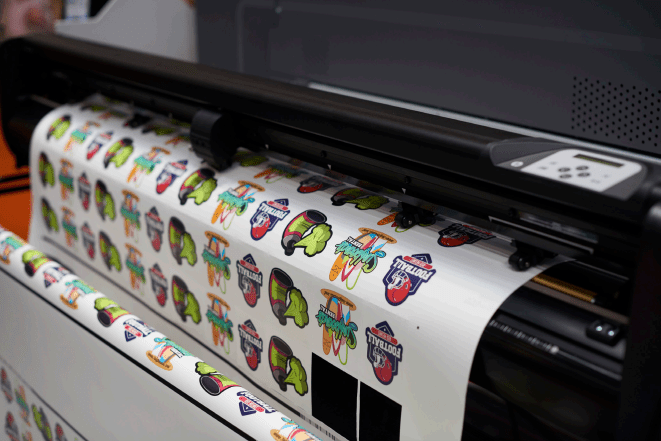This is the third article in our series focused on different types of labels and their use.
In our previous piece, we looked at ‘heat’ and ‘chemical’ resistant labels. This time we’re looking at ‘sheet fed laser’ and ‘inkjet’ labels.
We will use our in-depth understanding of all things related to labels to explain how they work, the advantages of their use and types of application.
How does inkjet and laser printing vary?
Before looking at the label materials we should understand the different print technologies.
Inkjet printing
Inkjet printing is a printing technology that uses tiny droplets of ink to create images or text on paper or other materials. The ink is sprayed onto the surface through a small nozzle or nozzles, which are controlled by a computer. The ink droplets are typically between 10 and 50 micrometres in diameter.
There are two main types of inkjet printing: thermal and piezoelectric. In thermal inkjet printing, tiny heating elements in the print head heat the ink, causing it to vaporize and form a bubble. The bubble then pushes a droplet of ink out of the nozzle and onto the paper. In piezoelectric inkjet printing, the ink droplets are expelled from the nozzle by the deformation of a piezoelectric material in response to an electric current.
Inkjet printers can produce high-quality prints with vibrant colours and sharp details, and they are relatively inexpensive compared to other printing technologies. However, the cost of replacement ink cartridges can be high and the ink can be prone to smudging or fading if not handled properly.
Laser printing
Laser printing on labels is a popular method for creating high-quality, professional-looking labels for various applications, such as address labels, product labels and shipping labels.
Laser printing is a type of digital printing technology that uses a laser beam to produce high-quality text and graphics on materials. The process of laser printing involves several steps, including rasterising the image, charging the photosensitive drum, exposing the drum to the laser beam, transferring the toner to the label material, and fusing the toner to the label with heat.
Laser printers, therefore, produce sharper, more precise text and graphics than inkjet.
Inkjet and laser label materials – their differences and suitability
Inkjet label materials and laser print materials differ in several ways. Here are some of the key differences:
- Material compatibility: Inkjet label materials are typically designed to absorb ink quickly and evenly, without smudging or bleeding. Laser print materials, on the other hand, are designed to withstand the high temperatures of the laser printing process without melting or warping.
- Image quality: Inkjet printers are generally better suited for printing high-quality, full-colour images with fine details and gradients. Laser printers can produce sharp text and graphics but may struggle with subtle colour variations or complex images.
- Durability: Inkjet labels can be more susceptible to fading or smudging over time, especially if they are exposed to moisture or sunlight. Laser labels, on the other hand, are more durable and resistant to fading and smudging.
- Cost: In general, inkjet label materials are less expensive than laser print materials. However, the cost of the printer and the ink or toner can vary depending on the specific model and brand.
Ultimately, the choice between inkjet label materials and laser print materials will depend on your specific needs and preferences, as well as the intended use of the labels. It is important to choose the right type of label material for your printing technology to ensure the best possible results.
Applications
Inkjet labels are suitable for short-run or custom labelling applications, such as product labelling, address labels or name tags.
Laser labels are more durable and resistant to water and light. These properties make them suitable for higher volume applications such as barcode labelling, shipping labels or asset tags.
Summary
Inkjet labels are more suitable for printing high-quality colour images and graphics, while laser labels are better for printing sharp, precise text and graphics, and are more durable and resistant to light. The choice between the two types of label materials depends on the specific application and printing needs.
Alternative solutions
Laser and inkjet compatible labels
There are labels which are compatible with both laser and inkjet printers. They are designed to work with both types of printing technology to ensure that labels can be printed with high quality and without any smudging or fading.
How are they used for both technologies?
The reason this material can be used for both printing technologies is predominantly due to the coating.
The label material is specially coated allowing ink to be absorbed by inkjet printers, while resisting toner adhesion for laser printing.
If you require labels for your business and need help selecting the most suitable type of label for your needs. Get in touch and one of our specialist team will guide you through the options and help you source it for the right price.
